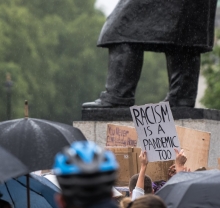Friday, March 5, 2021
We continue to survey the arts field on the pandemic’s impact on artists and creative workers, and this week a new blog by Research & Evaluation Manager Isaac Fitzsimons sheds additional light on the challenges faced by intentionally marginalized communities—many of which are not new, but have been exacerbated by the pandemic. Also on the blog, in her new role as Vice President of Equity, Ruby Lopez Harper explores longstanding inequities in the way artists and arts programs are funded and challenges funders with necessary actions to effect systemic change in grantmaking. And the importance of a robust and equitable arts sector is reinforced in a blog by Vice President of Research Randy Cohen showcasing new research that demonstrates the power of the arts as a tool for economic recovery at the local and state level.
Also this week, a three-hour intensive workshop explored community values and representation in public art; a recording of the discussion is available for viewing on ArtsU. And we opened nominations for our annual Leadership Awards—if you or someone you know is an exceptional leader in the field, let us know about it!
ARTSblog
Not just now, but always. Funders must center equity. by Ruby Lopez Harper
The last year brought forward a spotlight on existing disparities in communities of color. Funders of all types, especially local and state arts agencies, must center access and equitable distribution of resources to fully support their whole community. Now is the time to consider how to restructure programs, build stronger relationships, and include communities of color, LGBTQIA+ communities, and the disability community in crafting solutions.
The Social Impact of COVID-19 on Intentionally Marginalized Artists and Creative Workers by Isaac Fitzsimons
Our survey findings shed light on the hardships and lived experiences of artists and creative workers, and while this emphasizes the current need for building an infrastructure where artists and creative workers can thrive, it’s important to note that many of these conditions have existed long prior to the pandemic. We must work to dismantle the systems that have allowed these conditions to continue and rebuild anew to create a better future for artists and creative workers in this country.
Sparking Economic Recovery Through the Arts by Randy Cohen
As government leaders work to position their cities and states for a post-pandemic recovery, new research shows why they too should look to the arts as an essential tool in their economic recovery arsenal. The arts are economic catalysts. They do not just reflect the state and local economy, but actually accelerate economic recovery. A growth in arts employment has a positive and causal effect on overall state employment.
News Room
Nominations for the 2021 Annual Leadership Awards Are Now Open!
The Annual Leadership Awards recognize the achievements of individuals, organizations, or programs committed to enriching their communities through the arts and will be acknowledged in conjunction with the Annual Convention happening virtually June 7-11, 2021. Nominations close Monday, March 29 at 9:00 a.m. ET. You must be an Americans for the Arts member to make a nomination, but nominees need not be members!
ArtsU
ArtsU Intensive: Community, Values, and Histories in Public Art
Whether reviewing current collections or creating a new artwork, the conversation of whom and what public art represents is a necessary dialogue to have with community members. Rewatch this 3-hour workshop and learn how to identify issues and historical context, ways to discuss sensitive topics within organizations and with community members, and what steps to take to develop an equitable community engagement plan for future public artworks.
Photo by James Eades on Unsplash.






